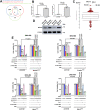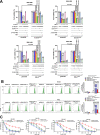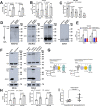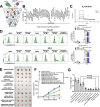Targeting SOX13 inhibits assembly of respiratory chain supercomplexes to overcome ferroptosis resistance in gastric cancer
- PMID: 38769295
- PMCID: PMC11106335
- DOI: 10.1038/s41467-024-48307-z
Targeting SOX13 inhibits assembly of respiratory chain supercomplexes to overcome ferroptosis resistance in gastric cancer
Abstract
Therapeutic resistance represents a bottleneck to treatment in advanced gastric cancer (GC). Ferroptosis is an iron-dependent form of non-apoptotic cell death and is associated with anti-cancer therapeutic efficacy. Further investigations are required to clarify the underlying mechanisms. Ferroptosis-resistant GC cell lines are constructed. Dysregulated mRNAs between ferroptosis-resistant and parental cell lines are identified. The expression of SOX13/SCAF1 is manipulated in GC cell lines where relevant biological and molecular analyses are performed. Molecular docking and computational screening are performed to screen potential inhibitors of SOX13. We show that SOX13 boosts protein remodeling of electron transport chain (ETC) complexes by directly transactivating SCAF1. This leads to increased supercomplexes (SCs) assembly, mitochondrial respiration, mitochondrial energetics and chemo- and immune-resistance. Zanamivir, reverts the ferroptosis-resistant phenotype via directly targeting SOX13 and promoting TRIM25-mediated ubiquitination and degradation of SOX13. Here we show, SOX13/SCAF1 are important in ferroptosis-resistance, and targeting SOX13 with zanamivir has therapeutic potential.
© 2024. The Author(s).
Conflict of interest statement
The authors declare no competing interests. This work was supported by the following grants: M.Z.M. discloses support for the research of this work from National Nature Science Foundation of China [grant number 81972213] and Natural Science Foundation of Shanghai [grant number 22ZR1412700]. K.L. discloses support for publication of this work from the National Nature Science Foundation of China [grant number 82072370], Program for Excellent Sci-tech Innovation Teams of Universities in Anhui Province [grant number 2022AH010074] Funding of “Peak” Training Program for Scientific Research of Yijishan Hospital, Wannan Medical College [grant number GF2019T01] and Funding of Climbing Peak Training Program for Innovative Technology team of Yijishan Hospital, Wannan Medical College [grant number PF201904]. H.Y. discloses support for the research of this work from the Health Research Program of Anhui [grant number AHWJ2023A30252], National Nature Science Foundation of China [grant number 81802503], Open Project of Key Laboratory of Non-coding RNA Transformation Research of Anhui Higher Education Institution (Wannan Medical College) [grant number RNA202205], Science and Technology Application Basic Research Project of Wuhu [grant number 2022jc60], Funding of “Peak” Training Program for Scientific Research of Yijishan Hospital, Wannan Medical College [grant number GF2019G15], Outstanding Innovative Research Team for Molecular Enzymology and Detection in Anhui Provincial Universities (2022AH010012). Y.Z. discloses support for the research of this work from the Key University Science Research Project of Anhui Province [grant number KJ2020A0594] and Key Health Research Project in Anhui Province [grant number AHWJ2022A021]. X.C.L discloses support for the research of this work from the Key University Science Research Project of Anhui Province [grant number KJ2020A0607]. Y.B.S. discloses support for the research of this work from Shanghai Municipal Health Commission Research Project [grant number 20194Y0242].
Figures










References
MeSH terms
Grants and funding
LinkOut - more resources
Full Text Sources
Medical
Molecular Biology Databases
Research Materials
Miscellaneous

